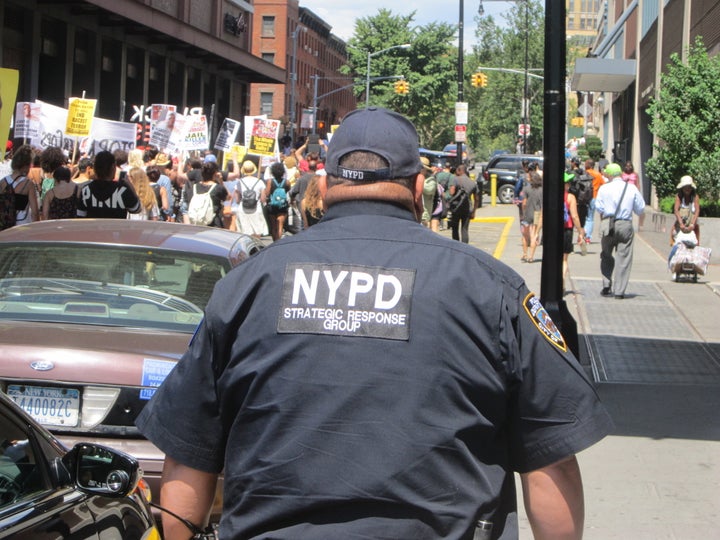
NYPD monitors Black Lives Matter march in August 2015.
As the nation gears up for further legal battles surrounding President Trump’s second Muslim travel ban, on Monday a federal judge in New York City approved a long-awaited settlement stemming from widespread New York Police Department spying on Muslims.
The question remains, however, is it enough to stop NYPD spying abuses, especially under the influence of the Muslim-obsessed Trump Administration?
The lawsuit Raza v. City of New York was filed in 2013 after the Associated Press published a Pulitzer Prize-winning series that exposed a vast domestic spying network developed by the NYPD in 2001. Raza plaintiffs argued that the NYPD violated their rights of equal protection and religious freedom.
Also in 2013, a decades-old class-action lawsuit was reopened. Similarly, the plaintiffs in Handschu v. Special Services Division argued that the NYPD spying network violated a consent decree imposed by the Handschu lawsuit.
Both Raza and Handschu were at the center of a debate over the past year as to whether the settlement agreement reached in January 2016, and corresponding changes to NYPD surveillance restrictions, were sufficient to address the breadth of abuses exposed by the Associated Press.
Long history of abusive spying by NYPD
The politically-charged Handschu lawsuit was filed in 1971, during the era of invasive and disruptive counterintelligence programs (COINTELPRO). National Lawyers Guild attorney Barbara Handschu and fifteen activists and political organizers accused the NYPD of violating their constitutional rights through the illegal use of informants, infiltration, interrogation, electronic surveillance, and summary punishment.
The Handschu case eventually established a consent decree governing certain NYPD practices, called the “Handschu Guidelines,” which aimed to restrict police surveillance and infiltration in order to protect the rights of people visiting and living in New York City.
But, after 9/11, the city went to court to relax the guidelines, claiming they impeded NYPD counterterrorism efforts and, in 2003, the court agreed. One of the most significant changes to the guidelines at that time was to eliminate oversight by the “Handschu Authority”—a three-person committee, including a civilian member—the only means the public had of holding the NYPD accountable.
Modifications to the Handschu Guidelines
Fortunately, the guidelines and settlement agreement approved this week once again imposes an oversight mechanism called the “Handschu Committee,” which includes a Civilian Representative (CR). However, the CR is dwarfed by ten other committee members all from the intelligence community and the CR must be an attorney appointed by the mayor in consultation with the police commissioner.
Many of the modifications can be subjectively interpreted and are unlikely to result in practical changes to NYPD practices, such as “the right to be free from investigation in which race, religion, or ethnicity is a substantial or motivating factor.”
Nothing is said about what the NYPD should do with the staggering amount of records it obtained during years of spying on Muslims in New York City, or the production, use, destruction and retention of records it obtains in the future.
The modifications also fail to address the ease with which investigations can be initiated and renewed. The NYPD can open a Preliminary Inquiry based merely on the “possibility of unlawful activity” and, remarkably, the allegations do not have to be “verified as true or accurate.”
The modifications institute time limits on investigations where there were none before, but they leave the indefinite extension of such investigations up to the sole discretion of the Deputy Commissioner of Intelligence.
The modifications do little to curb spying by undercover officers and informants, providing infiltrators with wide discretion to determine whether “the information sought could not be reasonably obtained in a timely and effective way by a less intrusive means.”
Rejecting the settlement agreement
Because of public outcry at the inadequacy of the 2016 proposed settlement agreement and a well-timed report issued in August by the Office of Inspector General (OIG) for the NYPD, US District Court Judge Charles S. Haight, Jr. rejected the agreement for not going far enough.
In October, Judge Haight unexpectedly issued a 41-page ruling which held that “[a]pproval of the proposed settlement in its present form,” under the circumstances would be “unreasonable.” Judge Haight asked the parties to go back to the drawing board to arrive at an agreement that will “furnish sufficient protection from potential violations of the constitutional rights of [plaintiffs].”
Although Judge Haight relied heavily on the OIG report which detailed routine failures by the NYPD to adhere to court-ordered restrictions, Judge Haight did little to try to correct what he called “systemic” issues.
The OIG found that police continued investigations and used confidential informants or undercover officers without approval more than half of the time. The OIG also found that police approved undercover investigations without a description of facts and used boilerplate text that was so routine the “same typographical error had been cut and pasted into virtually every application OIG-NYPD reviewed, going back over a decade.”
The OIG also failed to link this routine negligence—or deliberate deception—to any potentially broader violations such as opening investigations under false pretenses.
Instead of addressing these glaring loopholes in the proposed agreement, Judge Haight’s recommendations focused exclusively on details of the Handschu Committee.
Specifically, Judge Haight wanted to: (a) expand the scope of the committee to include “review and monitoring of the NYPD’s compliance with all of the Handschu Guidelines for investigating political activity,” (b) ensure that the CR could communicate directly with the court as needed, and (c) deny the mayor “unfettered veto power” to terminate the role of CR after five years.
And, while some improvements were made at Judge Haight’s recommendation to arrive at this week’s approved settlement agreement, it still remains unclear whether the CR and the Handschu Committee can adequately protect New Yorkers from NYPD abuses in the era of Trump.
As the dust settles from this long-winded effort to restrict NYPD spying practices, perhaps the biggest affront to the plaintiff class (ostensibly all New Yorkers) is the refusal by NYPD to admit any wrongdoing. As is typical in lawsuit settlements, defendants can deny any and all liability, which is exactly what they did.
Indeed, the NYPD is asking us to suspend disbelief by denying it “had or [has] a policy, or engaged in or currently engage[s] in a pattern or practice of conduct, that violated the Modified Handschu Guidelines.”
Kris Hermes is an activist, legal worker and author of Crashing the Party: Legacies and Lessons from the RNC 2000 (PM Press).
